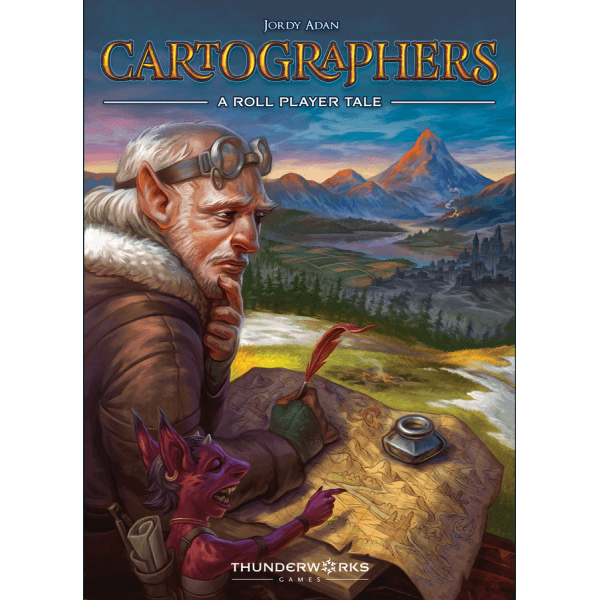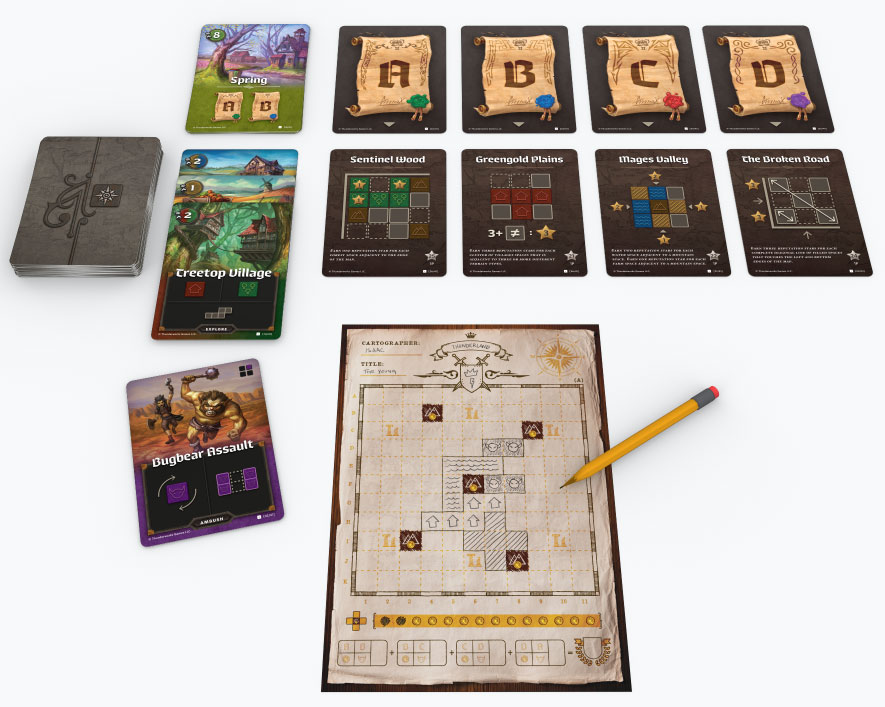Chart New Territories as a Mapmaker in Cartographers: A Roll Player Tale

Fill in a grid with various terrains in this flip and write adventure in the Roll Player universe.
Gameplay
Cartographers: A Roll Player Tale is a game for 1-100 players (the game includes 100 sheets, thus the limitation on players) that tasks players with creating maps by flipping over differing terrain cards. Players will do this through four seasons (beginning in Spring and ending in Winter), each a bit shorter than the previous. Player sheets contain ruins and mountains. Ruins can only be built upon when a special condition is met, and mountains can only be built around. However, surrounding mountains while mapping out terrain will earn players a coin (which can be factored into final scoring for each season).
Players begin by setting out the four marker cards labeled A-D. Then, players will separate the scoring cards into four piles, each representing a different scoring condition, then pick one from each pile and place them under each of the four marker cards. Finally, players will choose from one of the four monster cards, picking one at random and inserting it into the terrain deck and then shuffling all the cards before placing them face down.
Play begins in Spring, with a player turning over the first terrain card and noting the number in the top left (with a value of 0,1, or 2). These numbers help determine when it’s time to score for a season. Spring and Summer last to a value of 8, Fall a value of 7, and Winter a value of 6. It is possible to exceed these numbers by one (for example, cards equal 7 in Summer and then a card is drawn that adds 2 to the value, totaling 9). Players will carry out the action(s) on the card, usually drawing a polyomino shape specifying several terrain options (marshlands, villages, farms, or rivers). Some cards give players the option of choosing between two different terrain options or choosing to create a smaller shape but earning a coin, which they will fill in on their player sheets. If the chosen shape cannot be legally drawn on a map, players may draw a 1 by 1 tile (of that terrain type) anywhere on their map.
Within the terrain deck are two types of other cards: ruins and monsters. When a ruin cards is drawn, the next card drawn will determine what is drawn on the sheet. On each player sheet, there are a handful of ruins which can only be drawn on when the ruin card is drawn. When a monster card is drawn, players will hand their sheets to the person to their right and that person can draw the shown shape anywhere (with the legal boundaries of the map grid) and hand it back to the other player. Once a monster card is drawn, and the action is complete, remove it from the game. In a solo game, players are given the freedom to draw the shape anywhere they choose on their own map. If a monster card is not drawn during any season, another monster will be added, and all terrain cards will be shuffled for the start of the next season.
Scoring for a season differs per round. In Spring, players will score the conditions under the A and B marker cards; in Summer they will score B and C; Fall will be C and D, and Winter will score D and A. Players will also total the number of coins they have gathered in each season, as well as note the number of monster tiles on their map that are next to unoccupied orthogonal spaces for negative points. At the end of the game, each season’s point totals are added together with the highest point total winning. In a solo game, players will add up their seasonal totals, but must also then add up the sums of the silver stars on each scoring card to subtract from their totals.

Review
Cartographers is a fantastic flip and write game. The deck is small, but tight, and the scoring variability by scoring multiple cards per season is a clever mechanism (similar to Isle of Skye). Not only are some scoring conditions obvious (largest village, marshlands extending to mountains, etc.) but there are some that are harder to accomplish (scoring completed diagonal rows from the left side to the bottom of the map).
Cartographers puts the mapmaking mechanism in the flip/roll and write genre to excellent use. The fun that comes with play with the natural variability of terrain types and shapes, not to mention the scoring conditions, create different puzzles to solve with each playthrough. Likewise, players may concentrate on specific terrain types (or perhaps drawing terrain at specific locations on the map) in one or two seasons, only to have to switch tactics to concentrate on other forms of scoring in later rounds. This prevents players from being able to run away with any game, because it’s difficult to manage even distribution in each phase of scoring. Therefore, one player may be doing well in Spring and Winter, while another does well during the Summer and Fall, according to how they have plotted out their own maps. The variability in player sheets (they are double sided, with the back having fewer spaces to build on thanks to a chasm) also provides added depth to replayability.
Pre-order copies also come with a mini-expansion, introducing a set of skills players can choose from while playing. Three skills cards will be picked at random at the beginning of the game, with players able to spend coins they have earned to use one of the skills once per season. Some skills may cost zero while others may be as expensive as three, so figuring out when to leverage skill use is key to gaining an advantage.
Players may be turned off by the trading of maps when a monster card is drawn, however this disadvantage can often be mitigated by minimally shifting one’s strategy. All it takes to reduce the negative damage of a monster area is to ensure it is surrounded by other terrain as the game moves along.
The solo variant offers an even bigger challenge as opposed to the multiplayer variant. The scoring card values (found in a silver star on the bottom of each scoring card) are subtracted from one’s solo score during the final tally. A game that seemingly was good can be instantly turned into one where a player ends up with negative points. The rulebook has a scale detailing a solo player’s success (30 and over being a great score) and depending on the luck of the draw with both terrain and scoring cards, it may be a tough game or an easy triumph. That amount of swing may be a turn off for gamers looking for a little more stability in flip and writes, but it is also what makes Cartographers: A Roll Player Tale such a compelling small box game. And considering a game only takes 15-20 minutes, players won’t feel the sting of a bad game for too long since the time investment is minimal but the replayability expandable.
Pros: Scoring variability, replayability due to variety of scoring and terrain conditions, easy to learn and hard to master
Cons: Solo variant can be tough with wild swings in scoring




